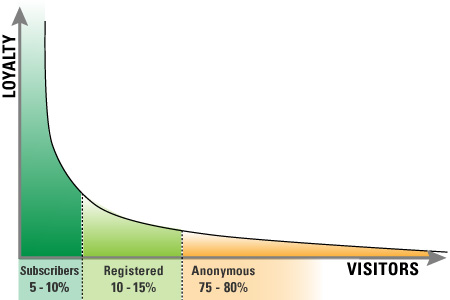Posted by: Matt Shanahan
In Chris Anderson’s The Long Tail, the theme was how low demand products could generate substantial revenue by rethinking sales and distribution. The argument is that selling less quantity but more products a company yields as much as selling more quantity but fewer products. Does the long tail apply to digital publishing? If so, how?
As the mantra goes, publishers sell audiences. In every website monitored by Scout Analytics, we find an audience defined by a long tail of visitors that looks like the graphic below. From this picture the long-tail rule may be focus on the short tail. In other words, selling more frequency from fewer visitors can yield as much as selling more visitors but less frequency.

Long Tail of Visitors
As a segment, subscribers tend to be small, 5-10% of audience, but deceptive. Subscribers are visitors who are keenly interested in the content on your website. They visit your site several times a week or more, and they consume more content per visit than any other group. They have the strongest loyalty and should be sold at the highest CPM.
Registered visitors usually make up 10-15% of the audience. They are regular visitors and will promote you by forwarding links, tweeting, or any number of growing “I like” tags. Registered visitors return to your website via a bookmark rather than a search engine. Their loyalty produces predictive behavior and deeper segmentation that can be monetized efficiently. They are also the best candidates to be made subscribers.
Anonymous visitors make up the bulk of an audience. They are casual visitors or just drive-bys. Anonymous visitors found your site via a search engine or a link in someone else’s content. Somewhere in that great lump of users are candidates for registration. Finding the ones closest in loyalty to registered visitors improves conversions.
As publishers deliver more targeted advertising, visitor loyalty needs to become a critical element of their monetization strategy. Making loyalty a part of the demographic provides more qualification of the inventory, better information for negotiations, and more control over delivery. Conclusion, Chris Anderson’s argument of selling less is more is true, but in digital media it takes a different lens and may be found in the short tail.






